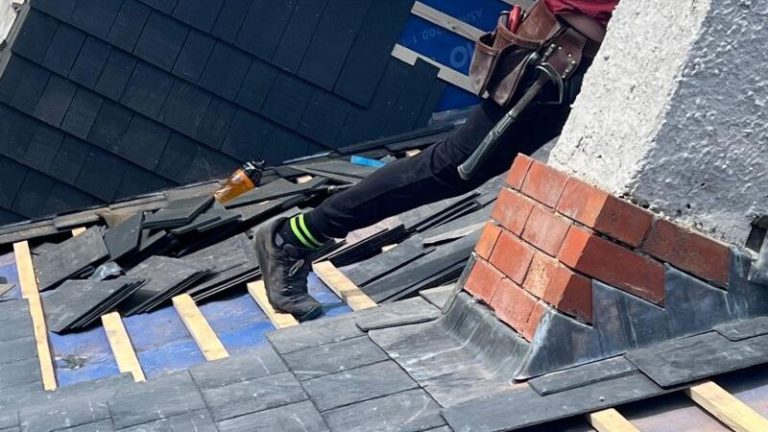Maximise Your Slate Roof’s Lifespan with Reliable Flashing to Prevent Costly Water Damage
Flashing acts as a crucial protective barrier at the most vulnerable points of your roofing system, especially where tiles meet walls, chimneys, or valleys. If flashing is not installed correctly, even a meticulously fitted slate roof can become susceptible to leaks over time, resulting in expensive repairs. Lead, known for its flexibility and exceptional durability, is the material of choice for flashing in slate roofing as it accommodates the natural movements of the roof structure. This ensures a secure seal that effectively prevents water from penetrating your roofing system.

Understanding Flashing: The Essential Element for Protecting Your Slate Roof
Flashing is a fundamental component that effectively seals joints and edges around structures such as chimneys, skylights, roof valleys, and any other areas where your slate roof intersects with walls or changes direction. These joints are particularly vulnerable to water infiltration; without effective flashing, they are frequently the first points to fail, resulting in leaks. Modern construction often utilises sheet metals for flashing materials, yet in traditional applications concerning slate roofs, lead remains the superior and preferred option.
What makes lead the optimal choice? This material not only seals effectively but also molds itself to create a robust barrier against various curves, slopes, and edges. It expands and contracts naturally with temperature changes, avoiding the risk of cracking or splitting. Unlike synthetic alternatives, lead does not rust and retains its integrity much longer, often outlasting the slate itself, thereby ensuring your roof remains safely protected for years to come.
Consequences of Ineffective Flashing: Understanding the Potential Risks
Even a minor tear or gap in your flashing can result in significant leaks. These leaks are rarely straightforward; water can penetrate beneath the tiles, reach the underlay, and gradually cause severe issues such as rot, mould, or damage to your internal ceilings. The repercussions of flashing failure may not be immediately noticeable, often taking years to manifest, and by that point, repairs can become extensive and costly. Problems arising from faulty flashing are among the primary causes of hidden roof failures that can threaten the structural integrity of your home.
If you observe stains on your ceiling, bubbling paint near a chimney, or patches of moss accumulating in certain areas on your roof, these could indicate that deteriorating flashing is the underlying issue. It is crucial to address these signs promptly to prevent more significant damage from occurring.
Why Lead Remains the Superior Choice for Flashing Materials in Roofing
For centuries, lead has been the go-to material for slate roofs due to its unique characteristics. It is recyclable, remarkably durable, and can endure harsh weather conditions, whether under intense heat or during severe storms. The malleability of lead allows it to fit snugly without risking damage to the fragile slate, which is often more delicate compared to lead.
Common applications for lead flashing include:
- Chimney flashings (both step and apron)
- Roof valleys
- Secret gutters
- Roof-to-wall junctions
- Ridge and hip intersections
- Skylight surrounds
These areas experience movement, pressure, and water runoff, making them particularly susceptible to failure when using hard, inflexible materials that can crack or become displaced over time.
Indications That You Should Consider Replacing or Repairing Your Lead Flashing
While lead flashing is renowned for its longevity, it will eventually show signs of deterioration. Consider replacement if:
- The lead has developed splits or cracks
- It is lifting or curling away from the roofline
- Visible rust is observed, especially where lead contacts other metals
- Water stains are noticeable inside your home
- You are planning a slate roof repair or rebuild
Most slate roof restorations include a thorough inspection of all leadwork. If we are already on your roof for tile replacement or cleaning, that is the perfect opportunity to assess and, if necessary, replace the flashing to ensure your roof remains watertight.
The Importance of Hiring Skilled Craftspeople for Leadwork Installation
Leadwork is a specialised trade that should not be assigned to just any general roofer or handyman. Improperly installed lead can sag, split, or detach from the slate, negating the benefits of a well-constructed slate roof. Our team utilises traditional methods for installing lead flashing, ensuring proper sizing, accurate lap joints, and expansion joints that accommodate the weather fluctuations typical in Sydney. We are dedicated to using lead only where it is the most suitable material for the task, ensuring quality and longevity.
How Quality Flashing Can Prevent Future Roofing Challenges
A slate roof can endure for a century or more, but only if its most vulnerable points are adequately protected. Flashing and leadwork may not be the most aesthetically pleasing components of a roof; however, they are essential elements that bear the brunt when weather conditions worsen. If you notice leaks, streaks, or signs of deterioration around your chimney or roof edges, it is imperative to have it evaluated without delay. Addressing flashing issues now can save you from incurring significantly higher repair costs for structural damage in the future.
Is It Time for a Professional Inspection of Your Leadwork?
If your slate roof features aging flashing that shows signs of wear, it is wise to have it inspected before minor issues escalate into costly damage. Contact us today to book an inspection with a team that is knowledgeable about slate, lead, and the intricate details that effectively hold your roof together.
Discover Key Questions Regarding Flashing and Leadwork
What is flashing on a slate roof, and why is it critical for roof integrity?
Flashing is the material utilised to seal joints and transitions in the roof—such as around chimneys, valleys, and skylights—preventing water from penetrating the roofing structure and causing potential damage.
What makes lead the preferred material for slate roof flashing?
Lead is renowned for its flexibility, high durability, and resistance to various weather conditions. It conforms to the contours of slate tiles and outlasts synthetic materials, making it the ideal option for ensuring a watertight seal.
What is the expected lifespan of lead flashing?
With proper installation, lead flashing can last for 50 years or longer, often outliving the slate roof it protects, thus providing long-term value for your investment.
Can flashing be repaired without replacing the entire roof?
Certainly, damaged or worn flashing can be repaired or replaced without requiring a full slate roof replacement, provided that the issues are promptly addressed to prevent further complications.
What are the signs of flashing failure?
Indicators of flashing problems include water stains near chimneys, damage to ceilings, moss growth in isolated areas, or visible gaps where roof surfaces meet. These signs should prompt immediate action to prevent additional damage.
Do all slate roofs require lead flashing?
Most slate roofs do. Areas such as chimneys, valleys, and wall junctions necessitate flashing, with lead being the preferred material due to its compatibility with slate and its proven effectiveness.
Is it safe to utilise lead flashing in residential properties?
Yes, when installed by professionals, lead flashing poses no safety risks. It remains the most effective and traditional choice for slate roofs, ensuring longevity and reliability.
The Article: Leadwork and Flashing: Why It’s Crucial for a Slate Roof first appeared on https://writebuff.com
The Article Leadwork and Flashing: The Importance for Slate Roofs Was Found On https://limitsofstrategy.com




